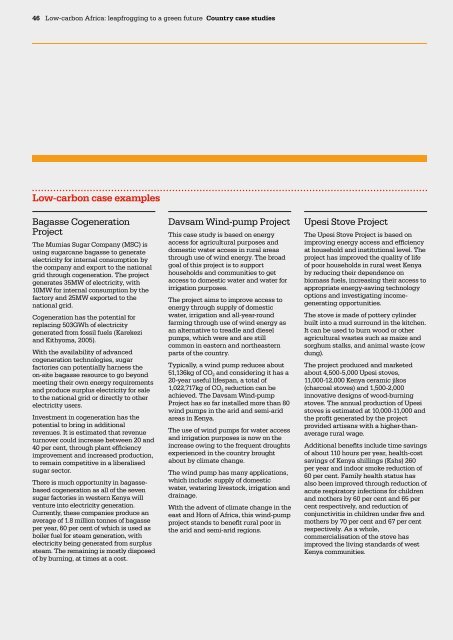Ju8uG
Ju8uG
Ju8uG
Create successful ePaper yourself
Turn your PDF publications into a flip-book with our unique Google optimized e-Paper software.
46 Low-carbon Africa: leapfrogging to a green future Country case studies<br />
Low-carbon case examples<br />
Bagasse Cogeneration<br />
Project<br />
The Mumias Sugar Company (MSC) is<br />
using sugarcane bagasse to generate<br />
electricity for internal consumption by<br />
the company and export to the national<br />
grid through cogeneration. The project<br />
generates 35MW of electricity, with<br />
10MW for internal consumption by the<br />
factory and 25MW exported to the<br />
national grid.<br />
Cogeneration has the potential for<br />
replacing 503GWh of electricity<br />
generated from fossil fuels (Karekezi<br />
and Kithyoma, 2005).<br />
With the availability of advanced<br />
cogeneration technologies, sugar<br />
factories can potentially harness the<br />
on-site bagasse resource to go beyond<br />
meeting their own energy requirements<br />
and produce surplus electricity for sale<br />
to the national grid or directly to other<br />
electricity users.<br />
Investment in cogeneration has the<br />
potential to bring in additional<br />
revenues. It is estimated that revenue<br />
turnover could increase between 20 and<br />
40 per cent, through plant efficiency<br />
improvement and increased production,<br />
to remain competitive in a liberalised<br />
sugar sector.<br />
There is much opportunity in bagassebased<br />
cogeneration as all of the seven<br />
sugar factories in western Kenya will<br />
venture into electricity generation.<br />
Currently, these companies produce an<br />
average of 1.8 million tonnes of bagasse<br />
per year, 60 per cent of which is used as<br />
boiler fuel for steam generation, with<br />
electricity being generated from surplus<br />
steam. The remaining is mostly disposed<br />
of by burning, at times at a cost.<br />
Davsam Wind-pump Project<br />
This case study is based on energy<br />
access for agricultural purposes and<br />
domestic water access in rural areas<br />
through use of wind energy. The broad<br />
goal of this project is to support<br />
households and communities to get<br />
access to domestic water and water for<br />
irrigation purposes.<br />
The project aims to improve access to<br />
energy through supply of domestic<br />
water, irrigation and all-year-round<br />
farming through use of wind energy as<br />
an alternative to treadle and diesel<br />
pumps, which were and are still<br />
common in eastern and northeastern<br />
parts of the country.<br />
Typically, a wind pump reduces about<br />
51,136kg of CO 2 and considering it has a<br />
20-year useful lifespan, a total of<br />
1,022,717kg of CO 2 reduction can be<br />
achieved. The Davsam Wind-pump<br />
Project has so far installed more than 80<br />
wind pumps in the arid and semi-arid<br />
areas in Kenya.<br />
The use of wind pumps for water access<br />
and irrigation purposes is now on the<br />
increase owing to the frequent droughts<br />
experienced in the country brought<br />
about by climate change.<br />
The wind pump has many applications,<br />
which include: supply of domestic<br />
water, watering livestock, irrigation and<br />
drainage.<br />
With the advent of climate change in the<br />
east and Horn of Africa, this wind-pump<br />
project stands to benefit rural poor in<br />
the arid and semi-arid regions.<br />
Upesi Stove Project<br />
The Upesi Stove Project is based on<br />
improving energy access and efficiency<br />
at household and institutional level. The<br />
project has improved the quality of life<br />
of poor households in rural west Kenya<br />
by reducing their dependence on<br />
biomass fuels, increasing their access to<br />
appropriate energy-saving technology<br />
options and investigating incomegenerating<br />
opportunities.<br />
The stove is made of pottery cylinder<br />
built into a mud surround in the kitchen.<br />
It can be used to burn wood or other<br />
agricultural wastes such as maize and<br />
sorghum stalks, and animal waste (cow<br />
dung).<br />
The project produced and marketed<br />
about 4,500-5,000 Upesi stoves,<br />
11,000-12,000 Kenya ceramic jikos<br />
(charcoal stoves) and 1,500-2,000<br />
innovative designs of wood-burning<br />
stoves. The annual production of Upesi<br />
stoves is estimated at 10,000-11,000 and<br />
the profit generated by the project<br />
provided artisans with a higher-thanaverage<br />
rural wage.<br />
Additional benefits include time savings<br />
of about 110 hours per year, health-cost<br />
savings of Kenya shillings (Kshs) 260<br />
per year and indoor smoke reduction of<br />
60 per cent. Family health status has<br />
also been improved through reduction of<br />
acute respiratory infections for children<br />
and mothers by 60 per cent and 65 per<br />
cent respectively, and reduction of<br />
conjunctivitis in children under five and<br />
mothers by 70 per cent and 67 per cent<br />
respectively. As a whole,<br />
commercialisation of the stove has<br />
improved the living standards of west<br />
Kenya communities.


